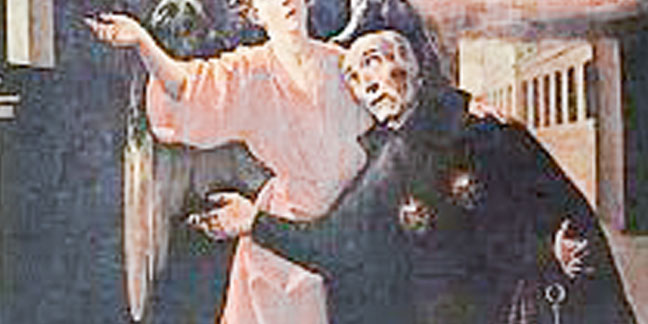 In 1916, the Angel of Peace appeared in Fatima, Portugal, to three shepherd children – Francisco, Jacinta and Lucia – teaching them the prayers that became the foundation for this Chaplet of Adoration and Reparation. As knowledge of Fatima spread, people began to say those prayers using a rosary. To encourage Eucharistic Adoration, Bishop Peter J. Jugis gave the chaplet his imprimatur in 2004.
In 1916, the Angel of Peace appeared in Fatima, Portugal, to three shepherd children – Francisco, Jacinta and Lucia – teaching them the prayers that became the foundation for this Chaplet of Adoration and Reparation. As knowledge of Fatima spread, people began to say those prayers using a rosary. To encourage Eucharistic Adoration, Bishop Peter J. Jugis gave the chaplet his imprimatur in 2004.
Using a rosary, you can pray this chaplet anytime, anywhere – an especially good devotion to practice in October, which is the month of the rosary, and for the feast of Our Lady of Fatima on Oct. 13.
Using the Prayers Taught by the Angel of Peace at Fatima, Portugal
Please pray this chaplet as often as you can -- anytime, anywhere -- especially at times and places where our Holy Triune God is most offended and unloved. (for public and private recitation on ordinary rosary beads)
Begin with:
Making the Sign of the Cross
(Kiss the Crucifix.)
Apostle’s Creed
(on the first bead and next three small beads:)
For the increase of Faith, Hope, and
Charity and the intentions of the Holy Father
1 Our Father / 3 Hail Marys / 1 Glory Be
(on the large bead before each decade:)
Most Holy Trinity, Father, Son, and Holy Spirit,
I adore you profoundly, and I
offer You the Most Precious Body, Blood,
Soul and Divinity of Jesus Christ,
present in all the tabernacles of the
world, in reparation for the outrages,
sacrileges, and indifference by which
He is offended, and by the infinite
merits of His Most Sacred Heart and
through the Immaculate Heart of Mary,
I beg the conversion of poor sinners.
(on the ten small beads of each decade:)
My God, I believe, I adore, I hope and I love You!
I ask pardon for those who do not believe,
do not adore, do not hope and do not love You.
(following the ten small beads of each decade:)
1 Glory Be
(and)
“O Most Holy Trinity, I adore You!
My God, My God, I love You in the most
Blessed Sacrament.”
(end Chaplet with Hail Holy Queen Prayer:)
Hail Holy Queen
Hail, Holy Queen, Mother of Mercy!
Our Life, our sweetness, and our Hope!
To Thee do we cry, poor banished children of Eve.
To Thee do we send up our sighs, mourning,
and weeping in this valley of tears.
Turn then, most gracious advocate,
thine eyes of mercy toward us;
and after this our exile show unto us the
blessed fruit of thy womb, Jesus.
O clement, O loving, O sweet Virgin Mary.
Pray for us O Holy Mother of God
That we may be made worthy of the promises of Christ. Amen
(Make the sign of the Cross)
In 1916, the Angel of Peace appeared in Fatima, Portugal,
to three shepherd children, Francisco, Jacinta, and Lucia
teaching them the prayers that became the foundation
for this Chaplet of Adoration and Reparation.
Jesuit lay brother encountered God in every task
 On Oct. 30, the Catholic Church honors a man whose humble occupation gave the world only glimpses of his extraordinary holiness. During his lifetime, Brother Alonso Rodriguez never became a priest, published a book or advanced professionally. But writings discovered after his death revealed a true mystic, who attended to a rich spiritual life while he worked as a doorkeeper and porter.
On Oct. 30, the Catholic Church honors a man whose humble occupation gave the world only glimpses of his extraordinary holiness. During his lifetime, Brother Alonso Rodriguez never became a priest, published a book or advanced professionally. But writings discovered after his death revealed a true mystic, who attended to a rich spiritual life while he worked as a doorkeeper and porter.
Born in Spain during 1532, Rodriguez married at 26 and worked as a cloth merchant, coming to religious life only through a string of crushing tragedies. His wife and two of their children died by the time he was 31, and his turn toward a life of prayer and penance could not prevent the subsequent death of his third and last remaining child – nor the discouraging failure of his business.
Without his wife and children, and having few prospects due to his lack of a higher education, the Spanish layman turned his thoughts to religious life. Even there, however, he faced difficulties. In his early years, Rodriguez had met one of the first Jesuits, Blessed Peter Faber. With his old life in ruins, he developed an interest in joining the recently established Society of Jesus.
His lack of education prevented Rodriguez from pursuing their course of priestly ordination, and he failed to acquire a diploma from the College of Barcelona despite attending for two years. The Jesuit Fathers in Valencia said he was unfit to join. But Rodriguez's years of prayer had not been in vain: they were answered when a provincial of the society, sensing his dedication, admitted him as a lay-brother.
In modern times, Jesuit brothers work in a wide range of fields, with few limitations apart from their lack of priestly ordination. During the 16th and 17th centuries, however, the lay-brothers of the Society of Jesus were known as "temporal coadjutors," and assisted the priests of the order by performing its more routine duties such as cooking, construction and farming.
The Jesuits sent Rodriguez to the college of Montesión, on the island of Majorca, to work as a porter and door-keeper. He assumed the responsibilities of receiving visitors and guests and carrying their luggage, tracking down students or priests when they were needed, delivering messages, and distributing alms to the poor. While other Jesuits traveled the globe evangelizing whole nations, and undertook a vast reform of the Catholic Church throughout Europe, Rodriguez carried bags and ran errands for 46 years.
But students began to seek him out, realizing that their doorkeeper was a man of unusual wisdom and faith. His Jesuit superiors started to take notice as well, and asked him to begin a private record of his life and thoughts. Rodriguez struck up a notable friendship with one young man, Peter Claver, and advised him to volunteer for the South American missions. Following his advice, St. Peter Claver eventually catechized, baptized and spoke out for the rights of 300,000 slaves in South America.
When Rodriguez died in 1617, his superiors examined the written records he had left behind describing his spiritual life. What they found was the life of a saint and mystic. His approach was simple: Christ was appearing in every person who appeared at the door; the task was to encounter God in any task. From this awareness, he proceeded to a life of contemplation akin to the renowned saints of his era (such as St. Ignatius or St. Teresa of Avila), whose grand achievements are better known.
Brother Alonso Rodriguez was declared a saint in 1887. He is buried on the same island of Majorca where he answered the door and carried bags for five decades.
— Catholic News Agency

